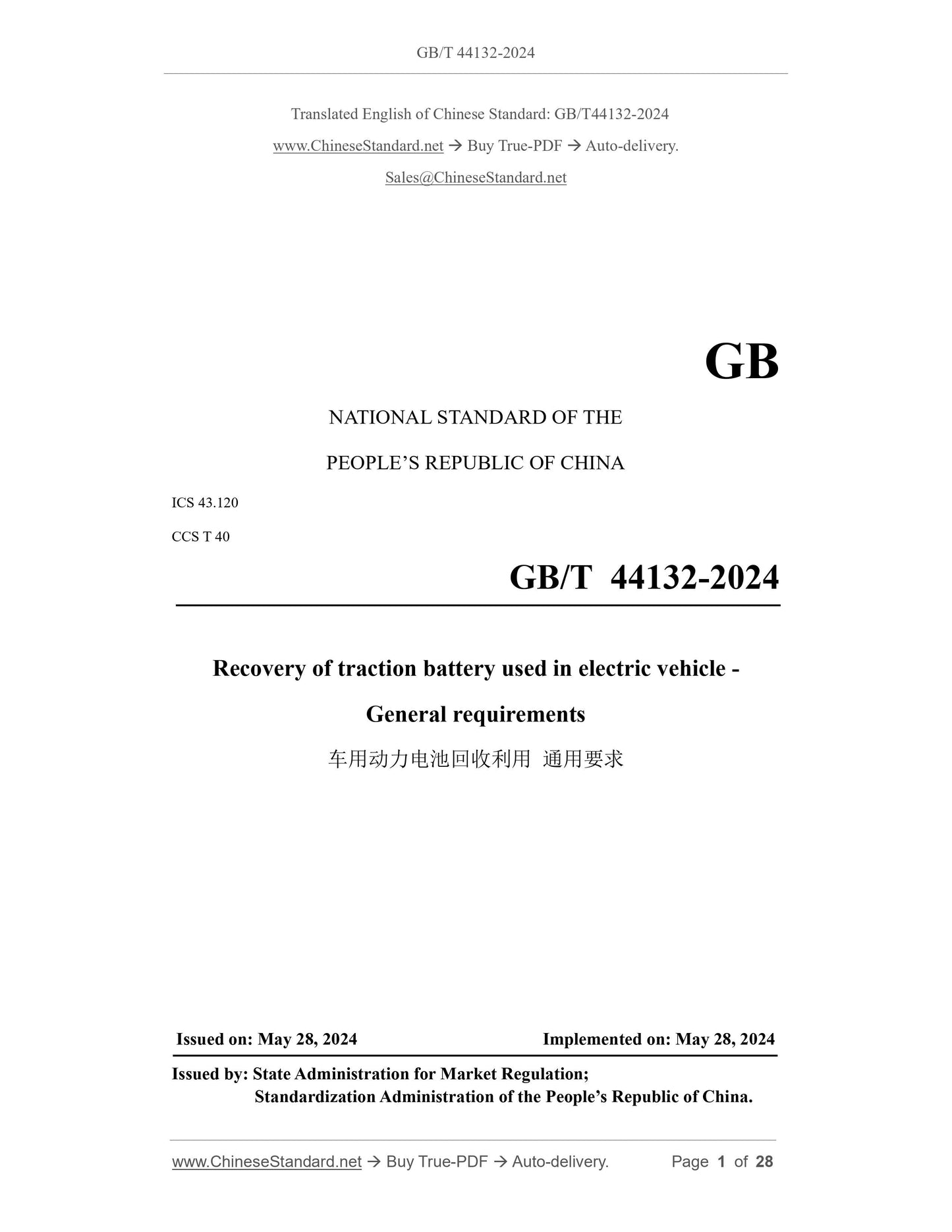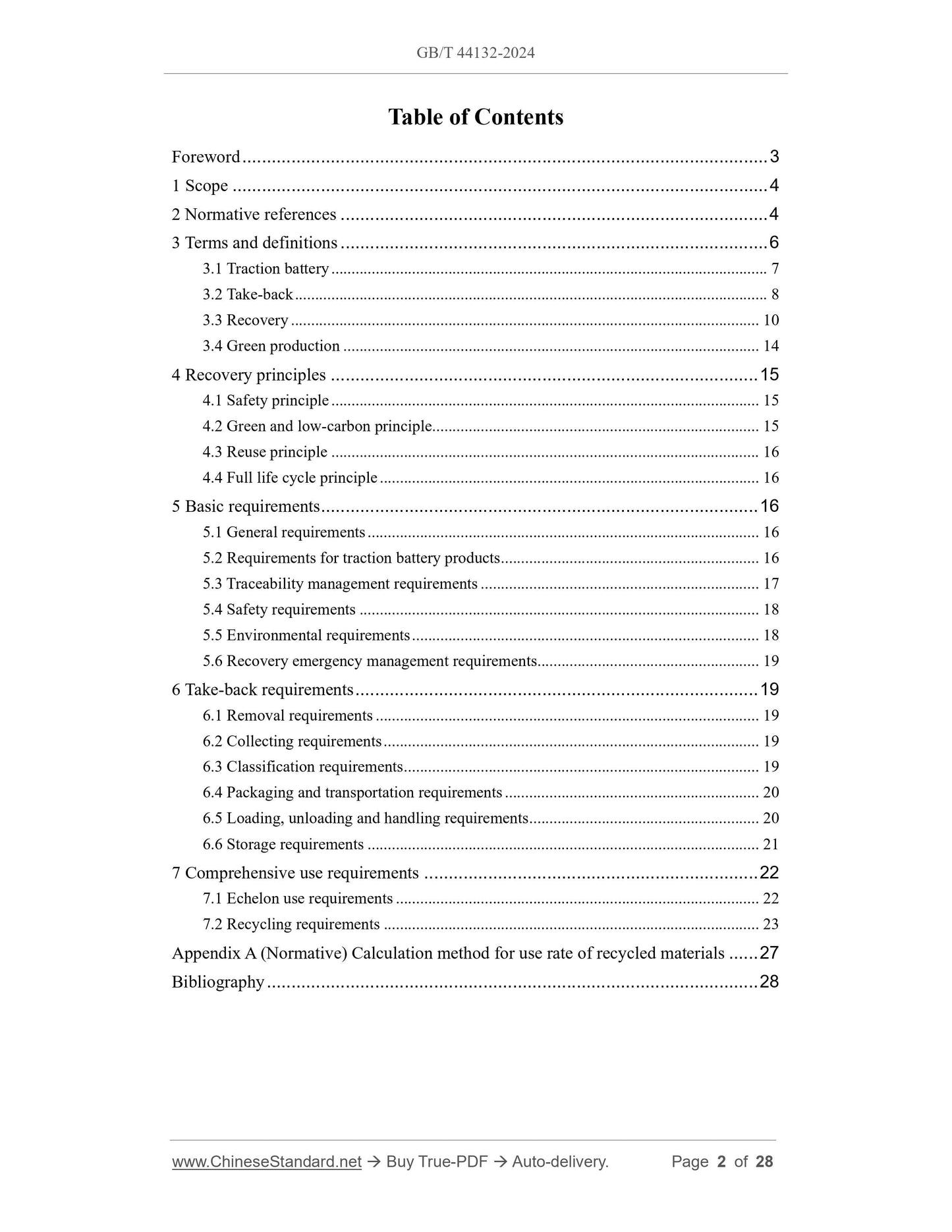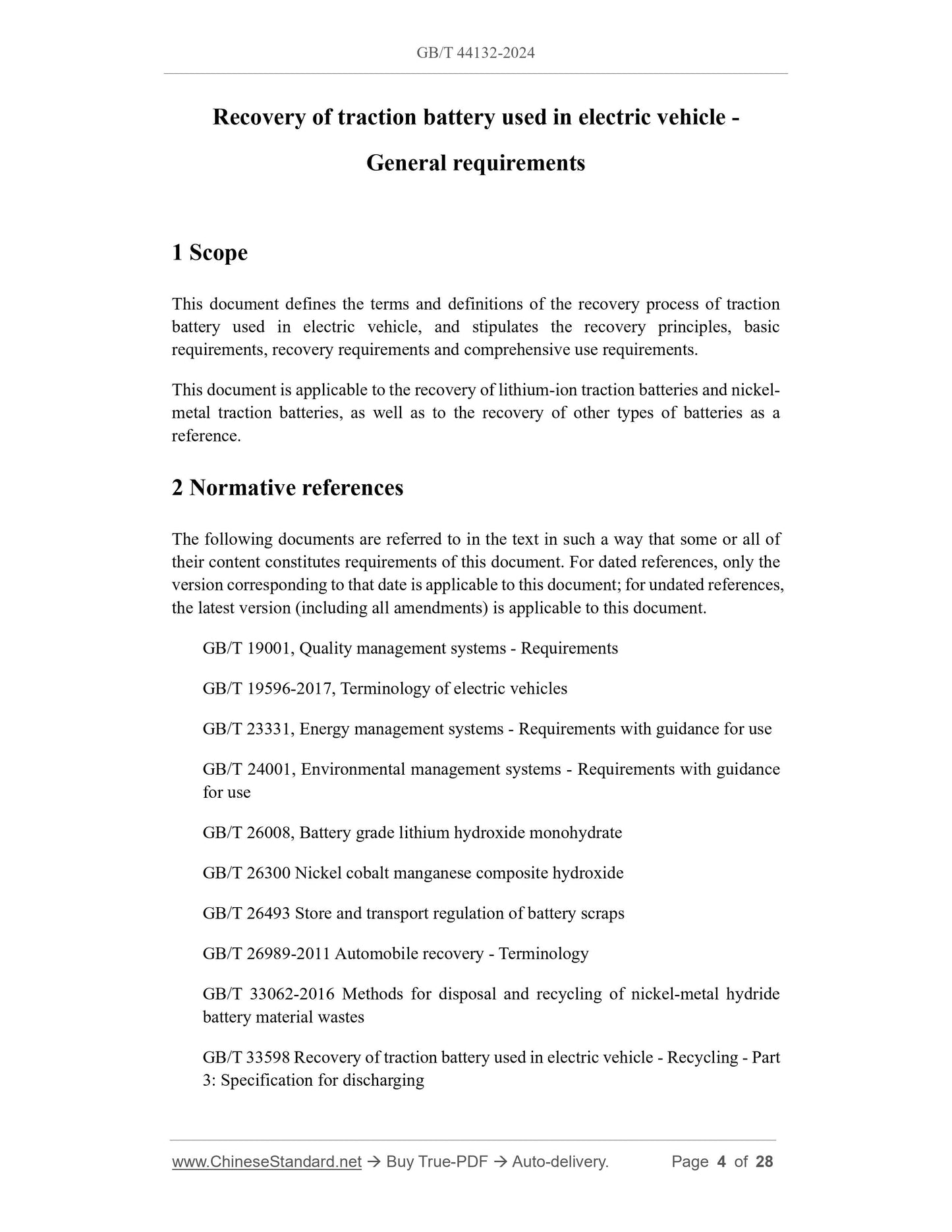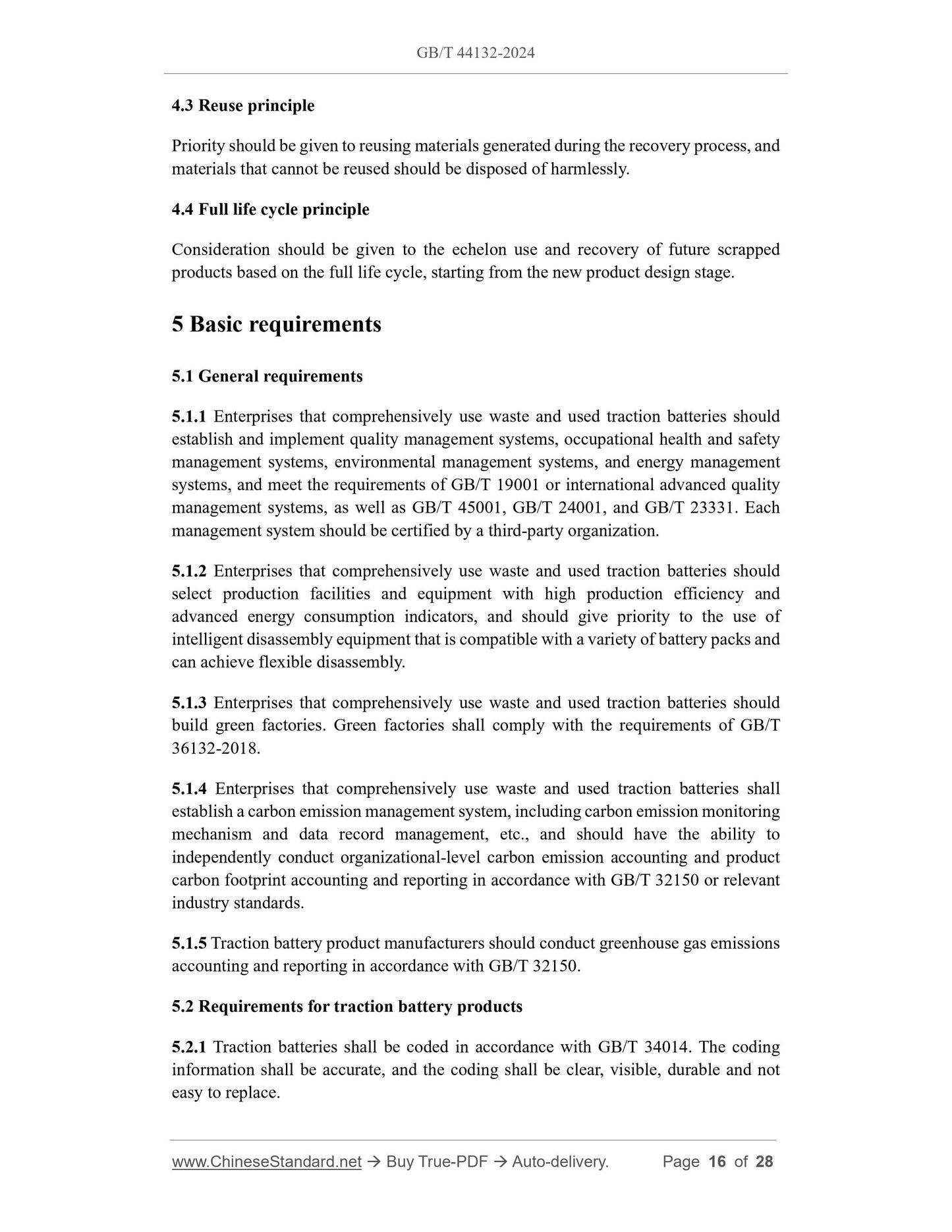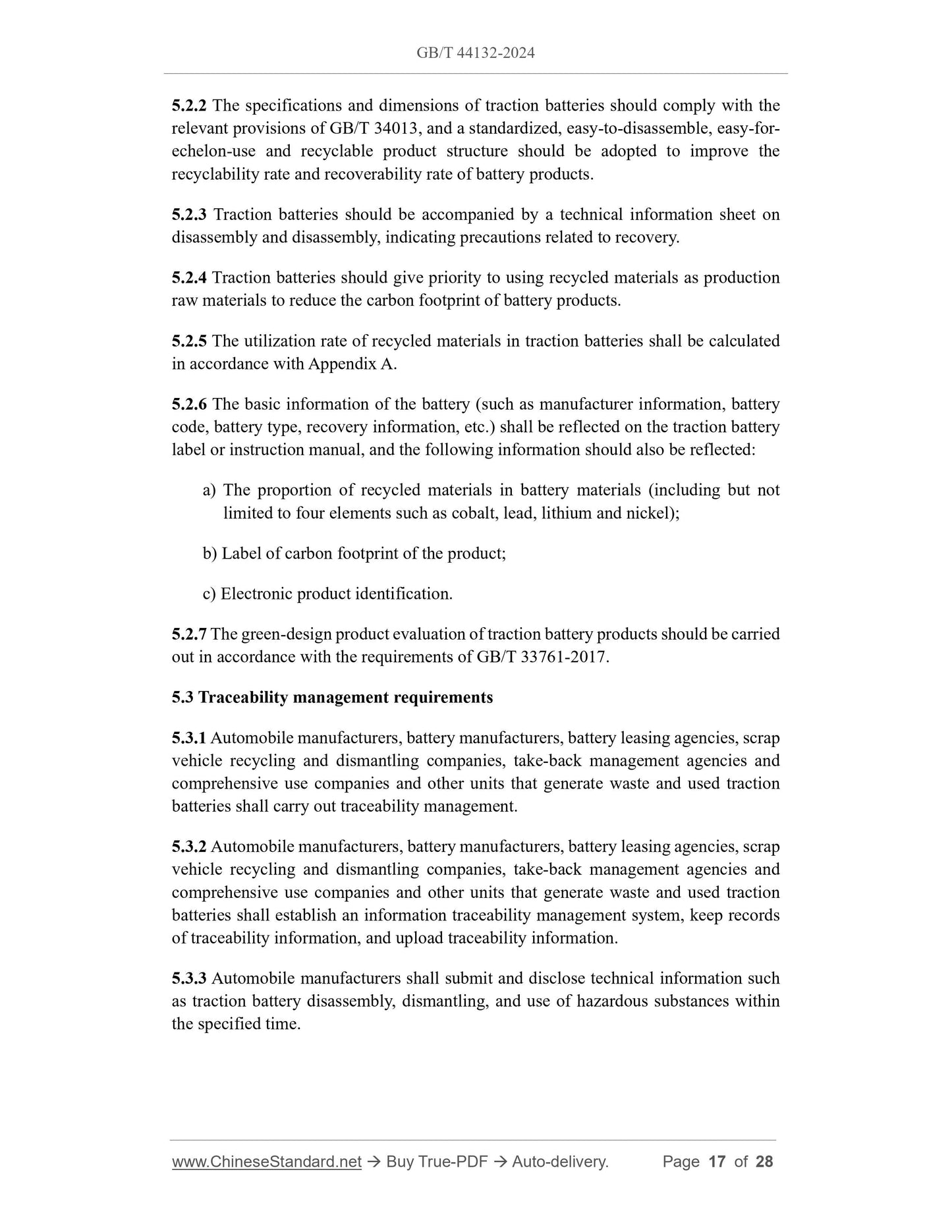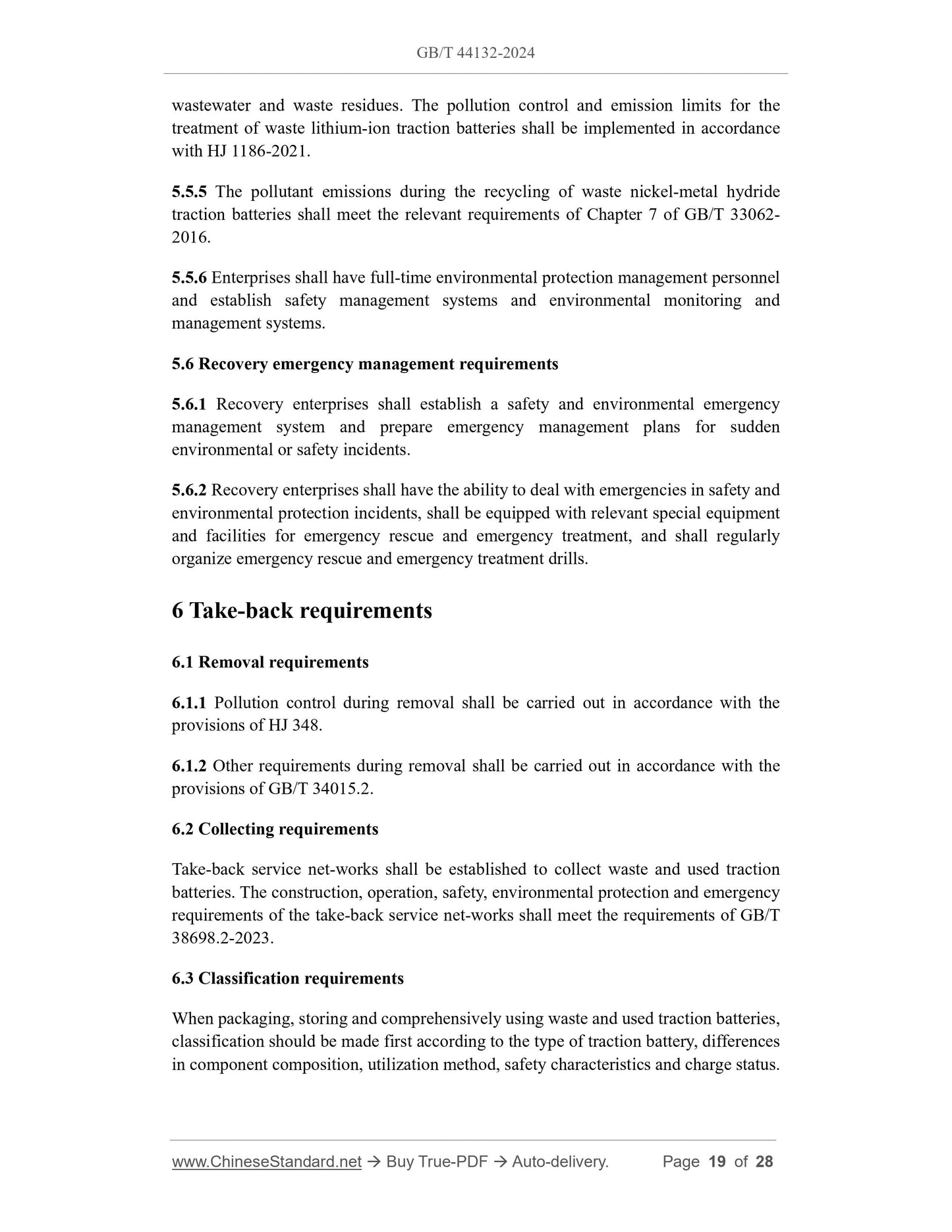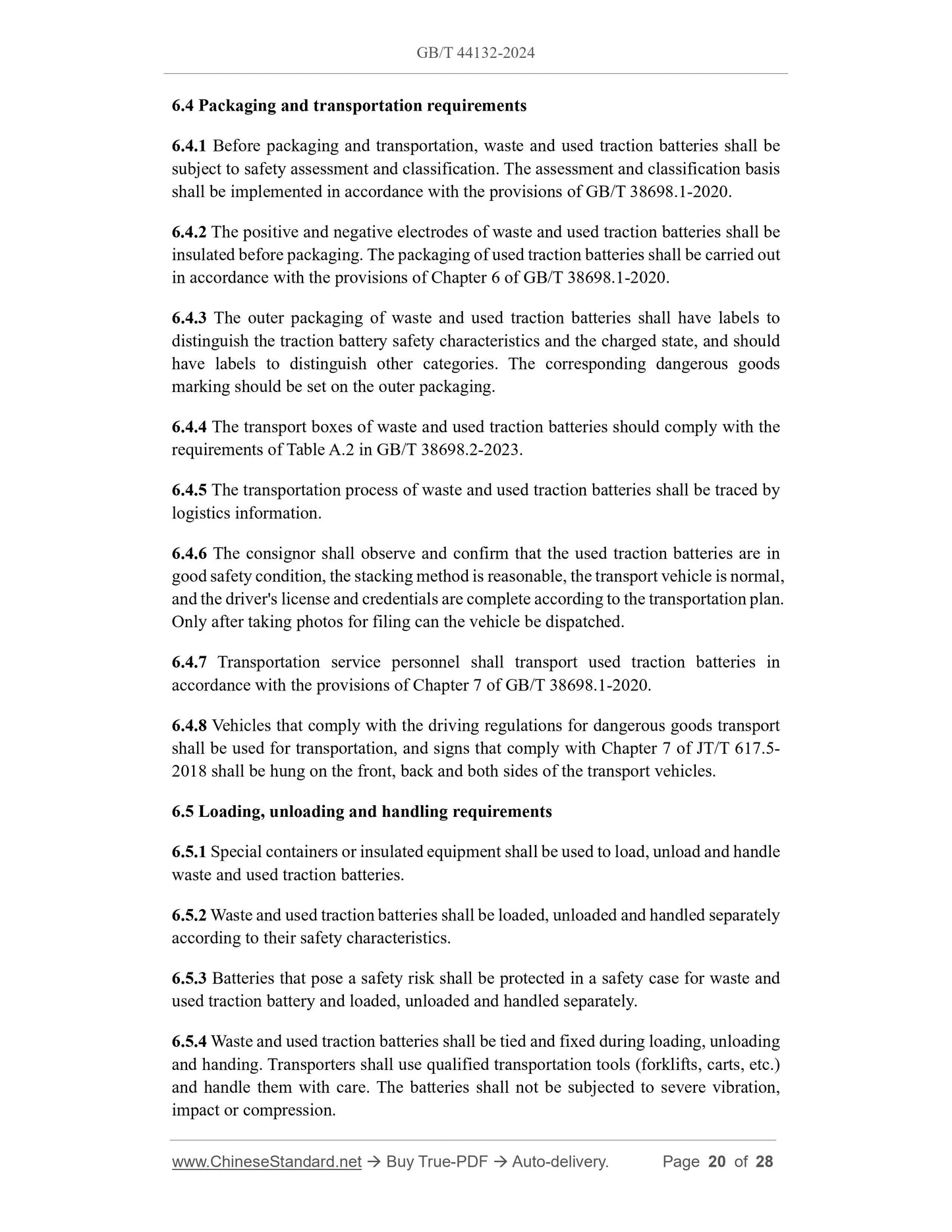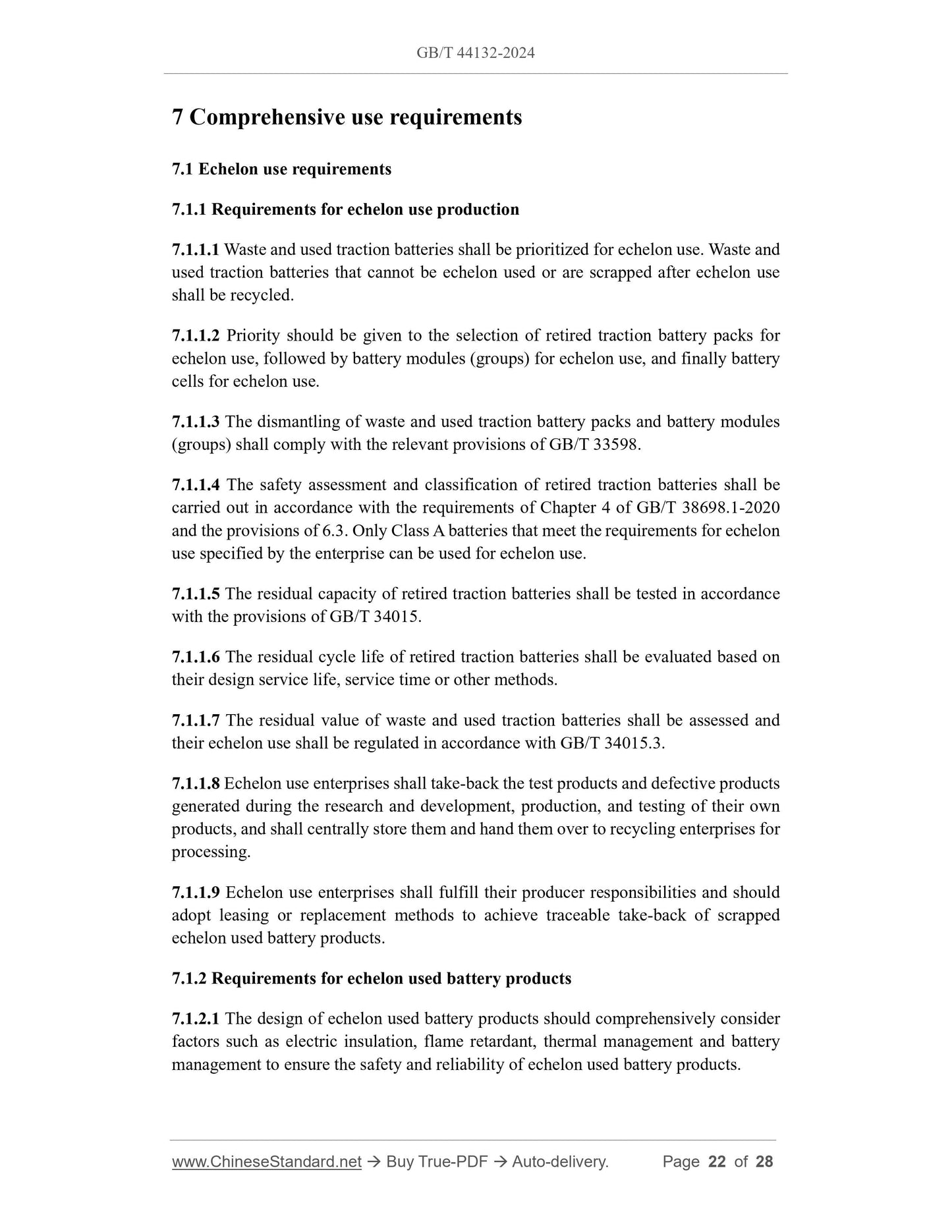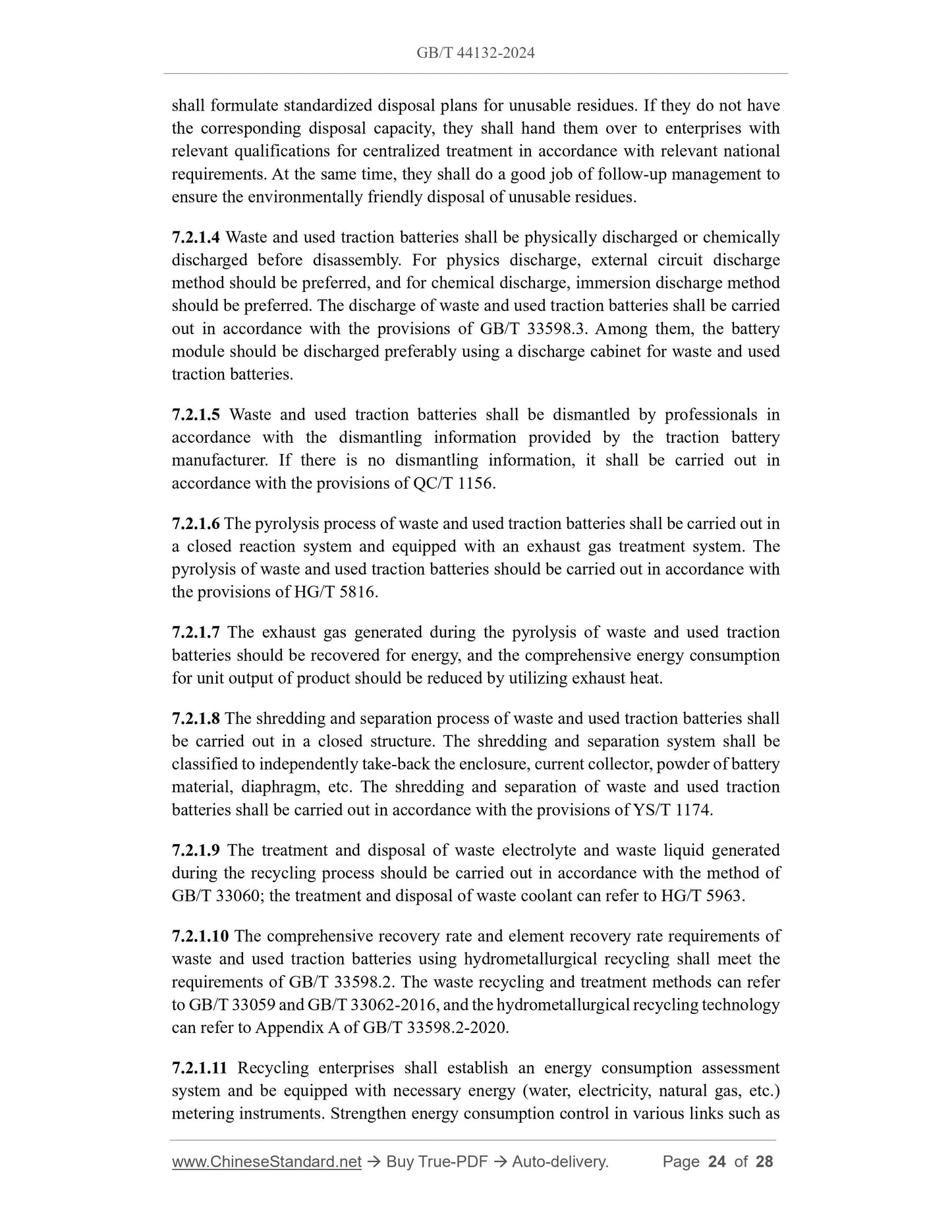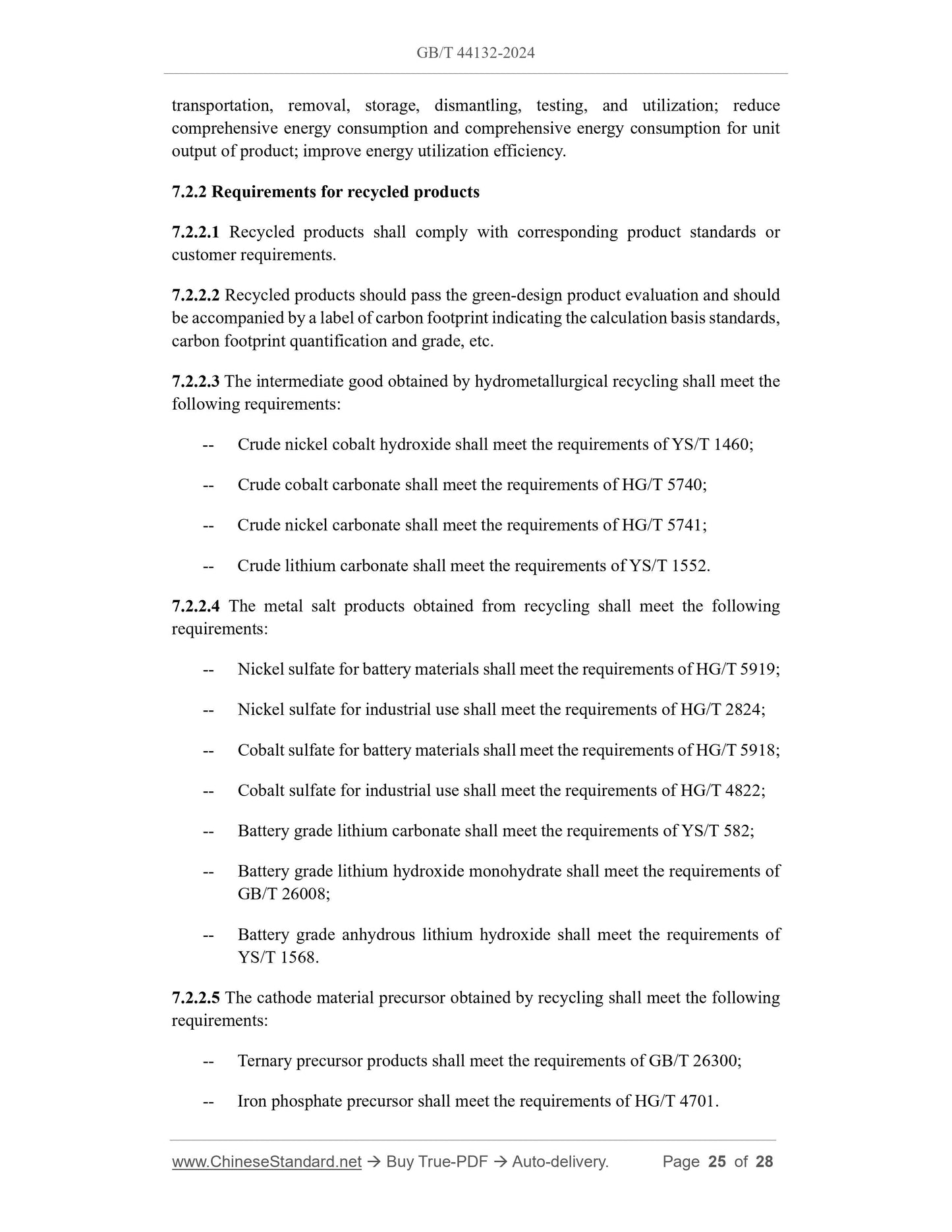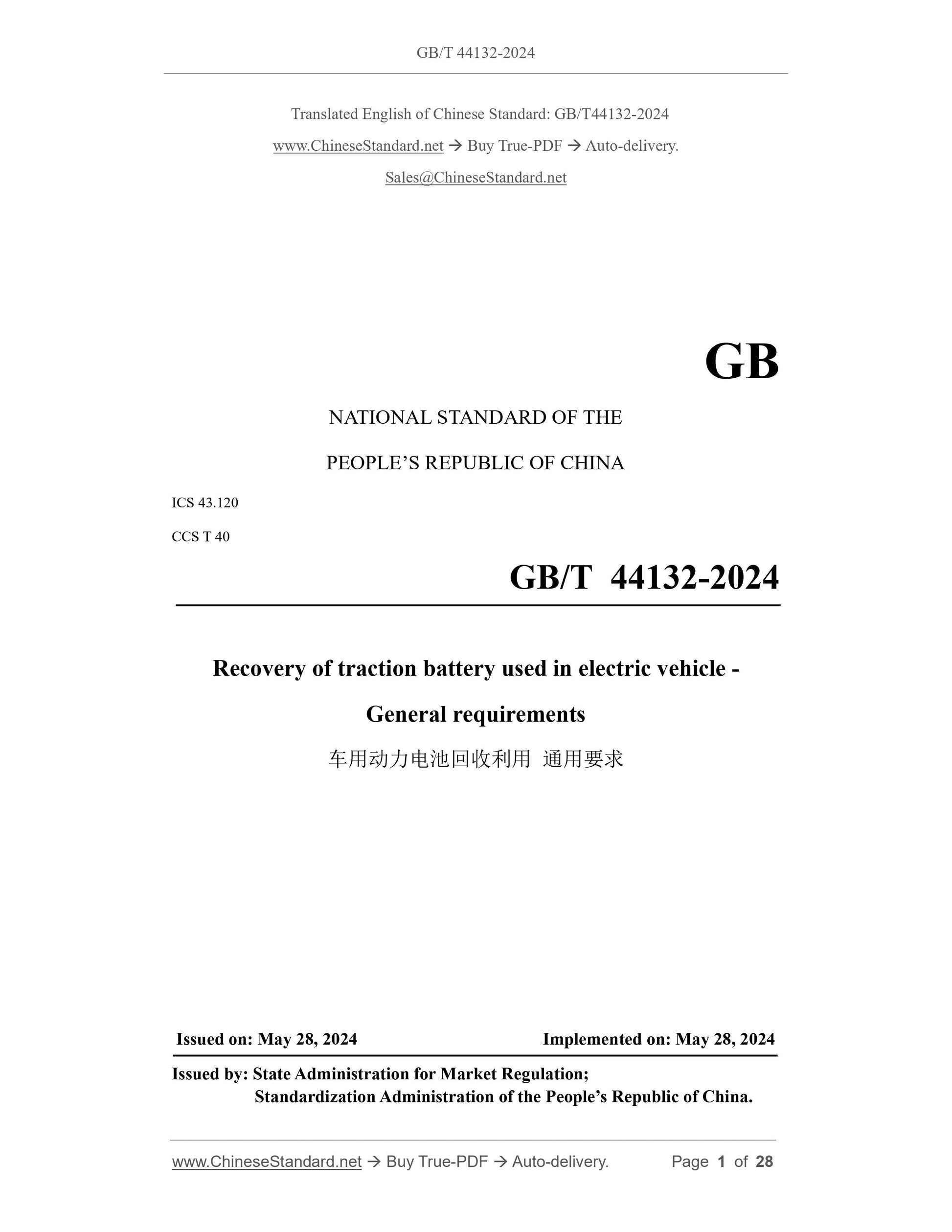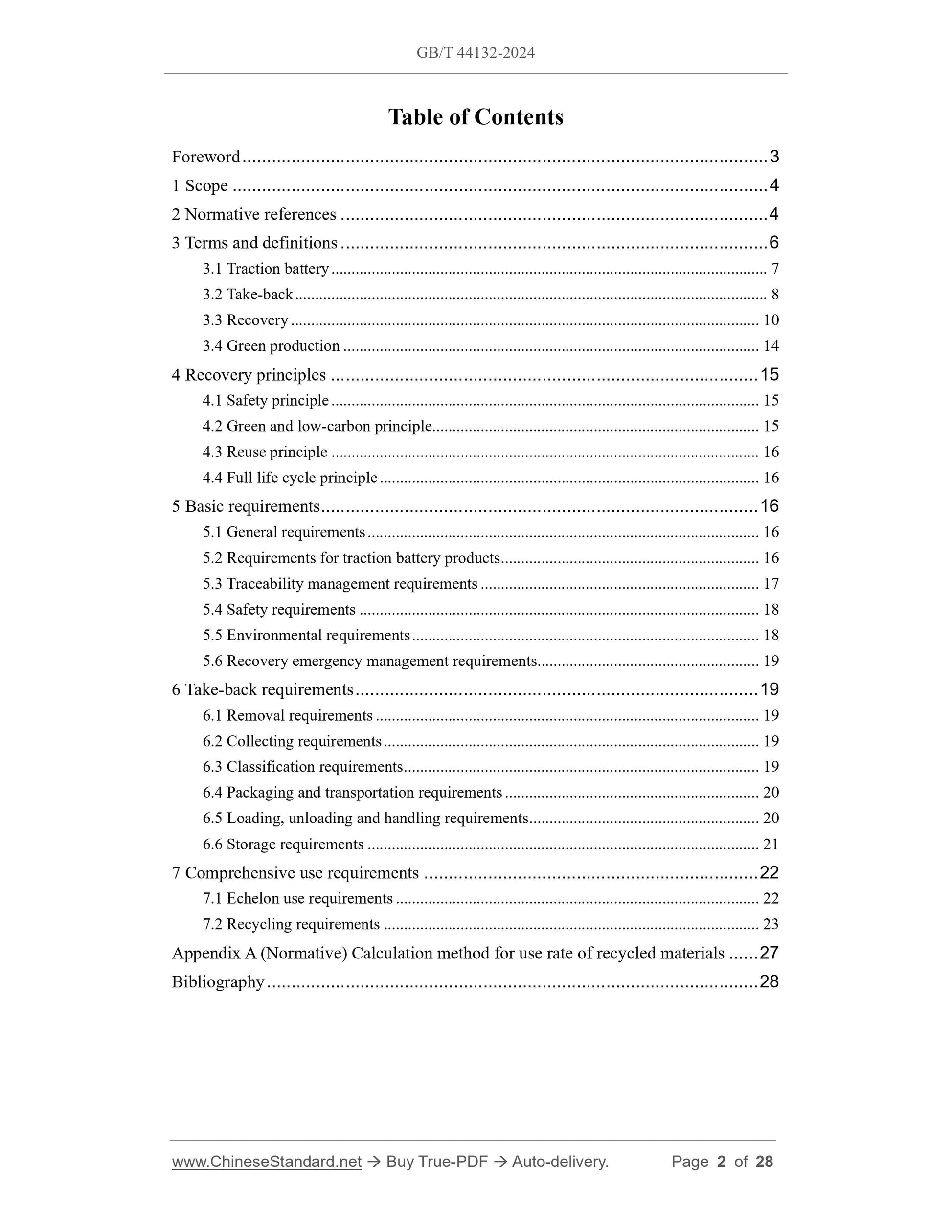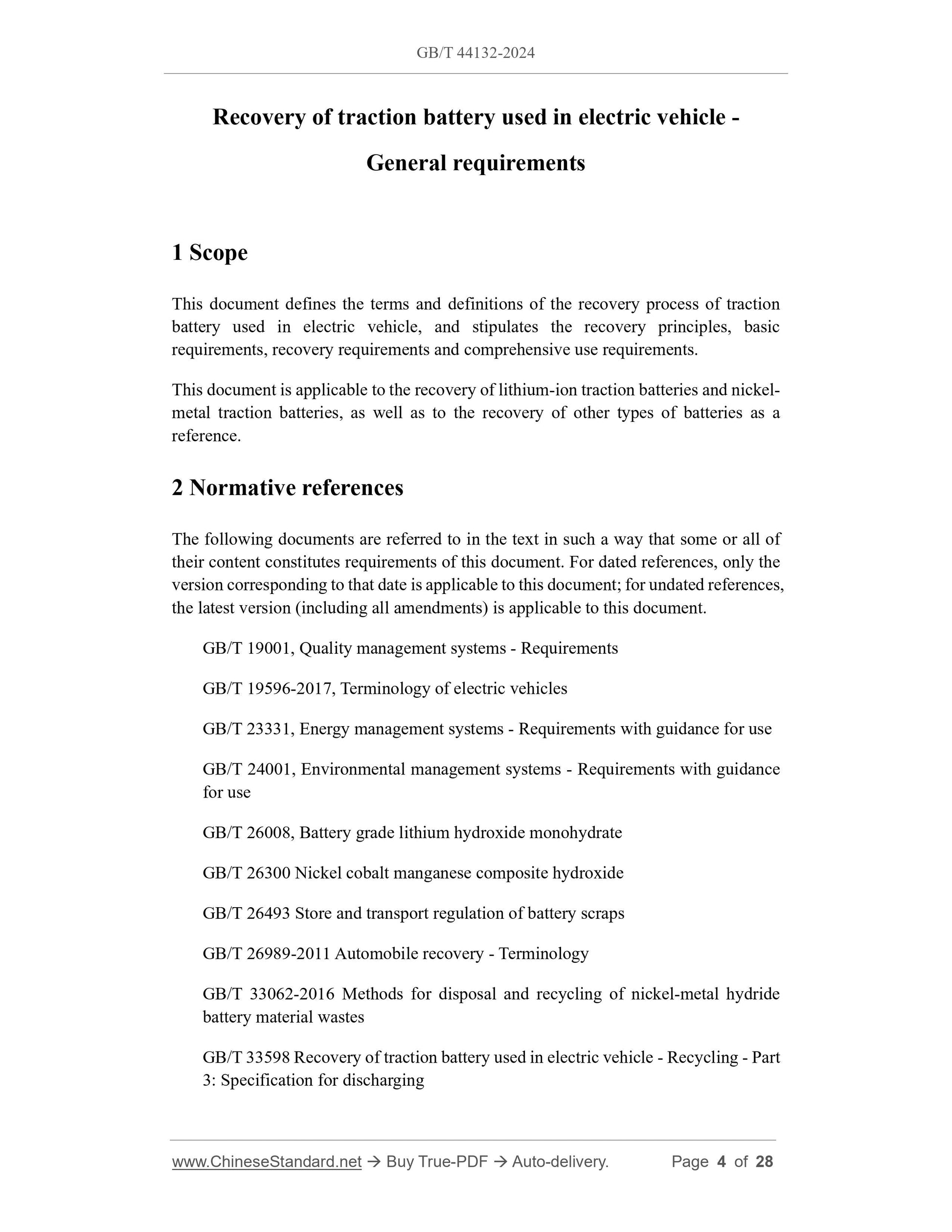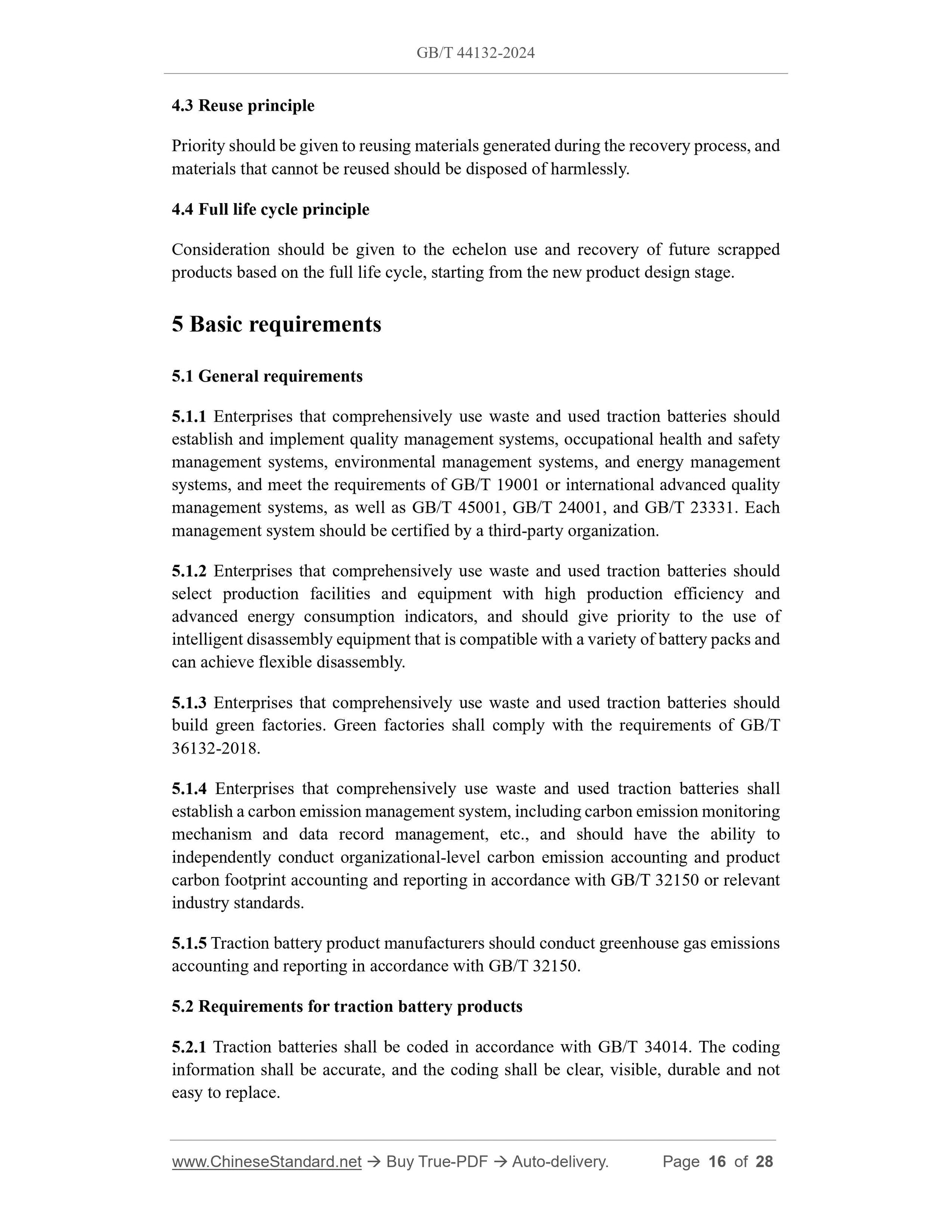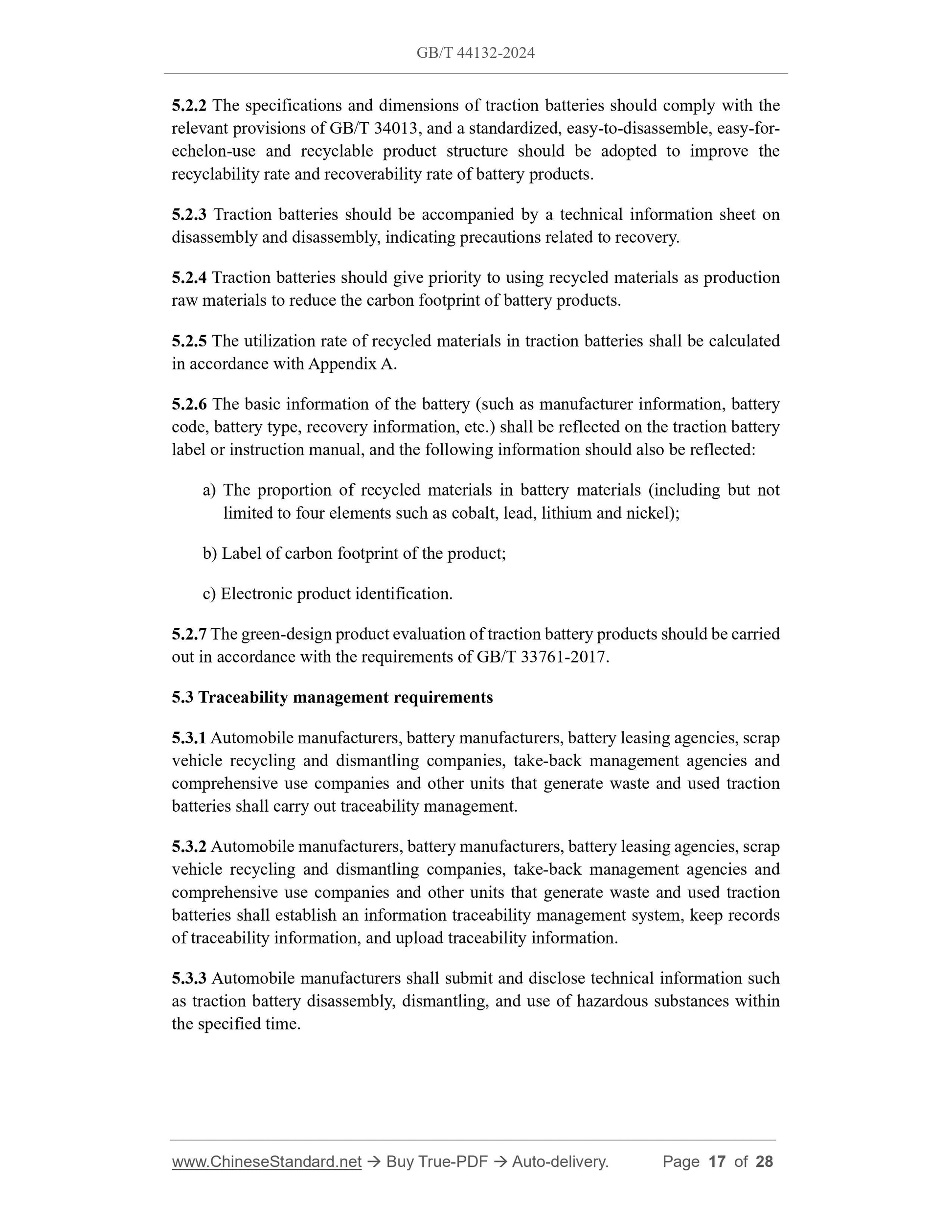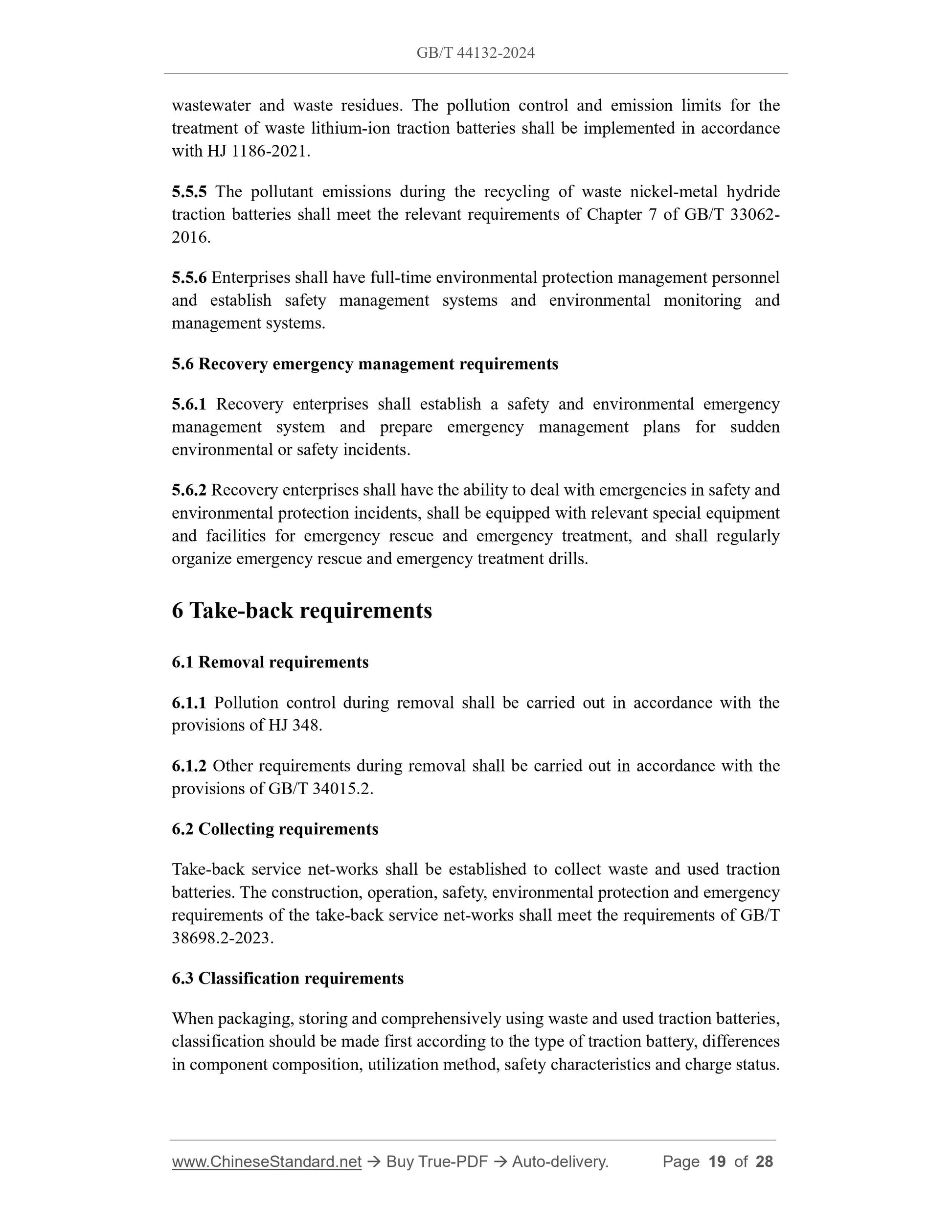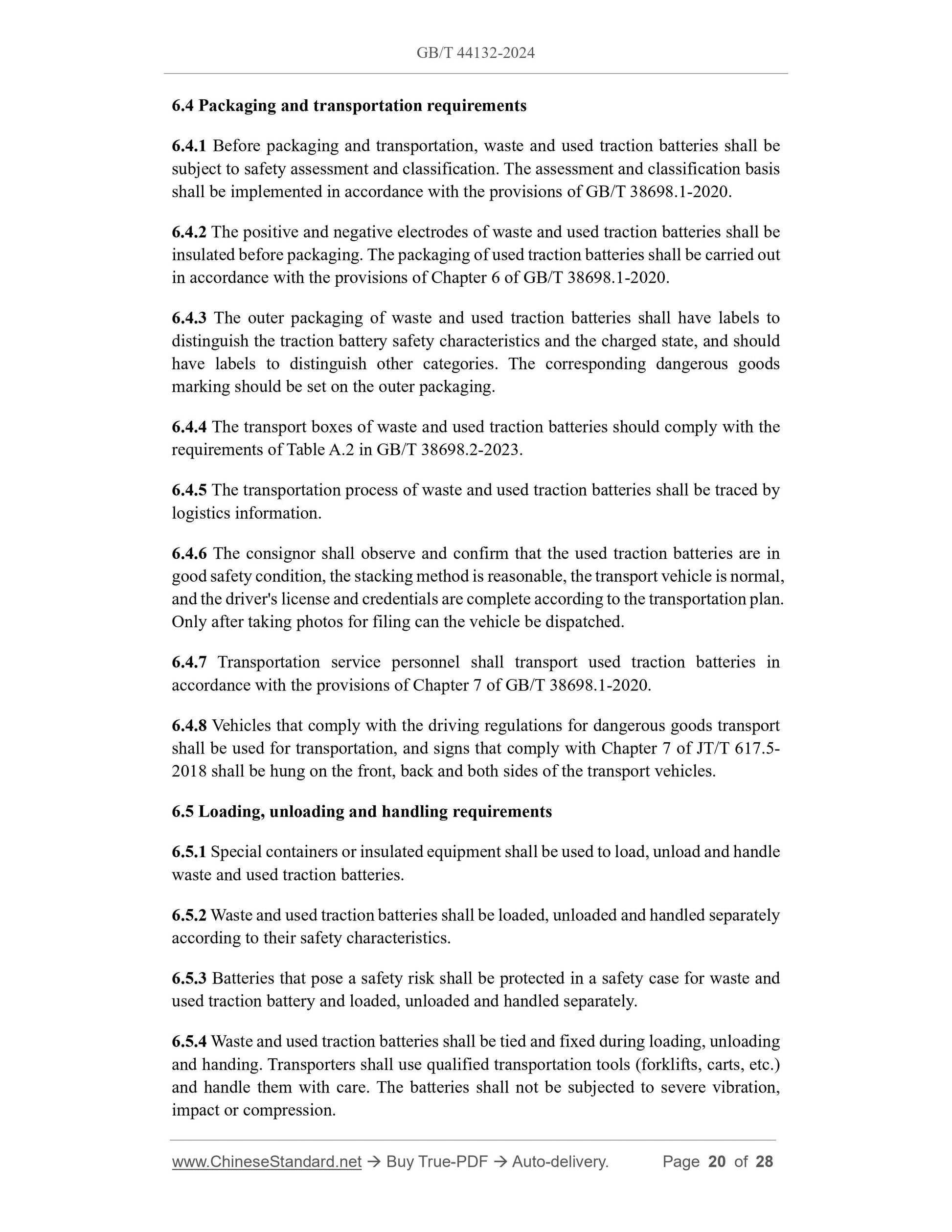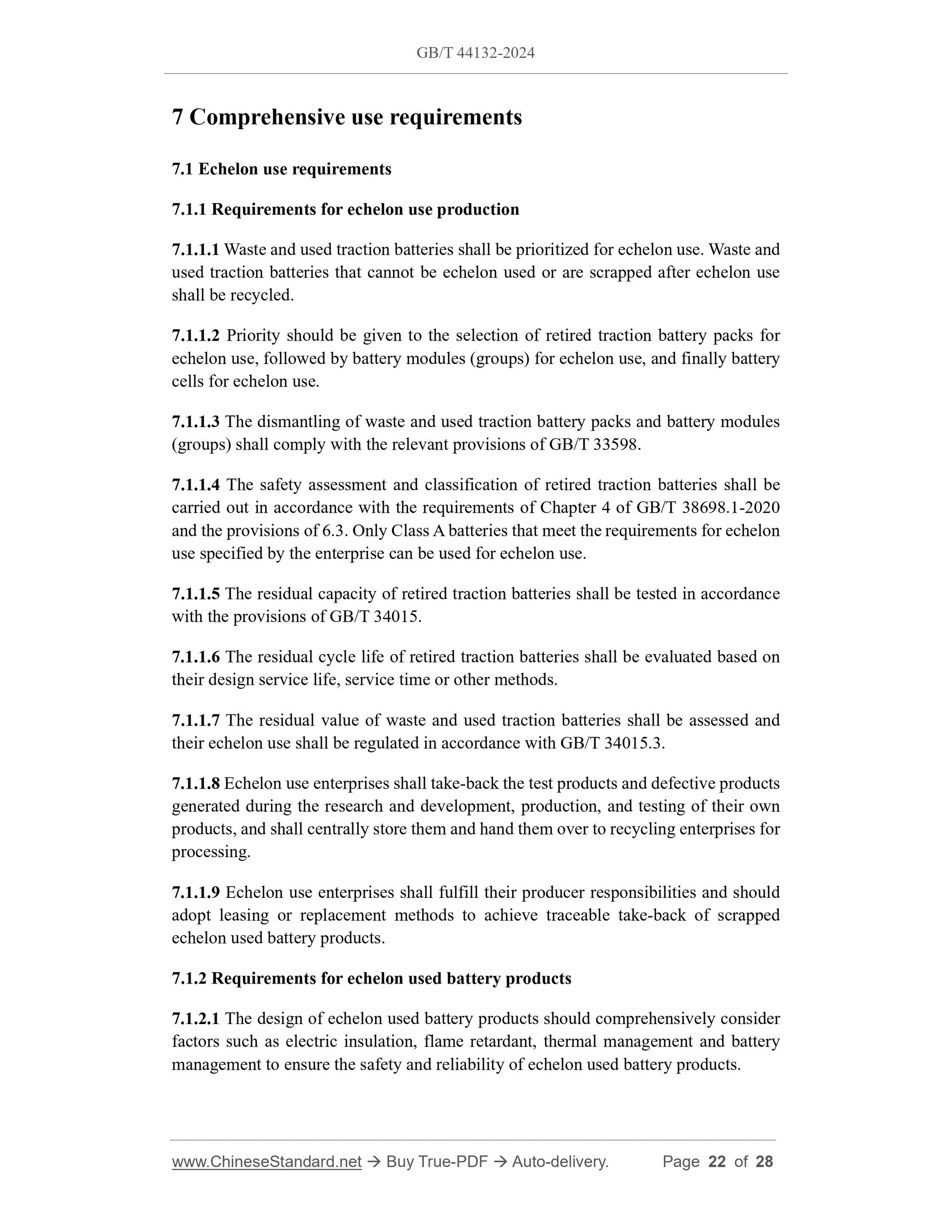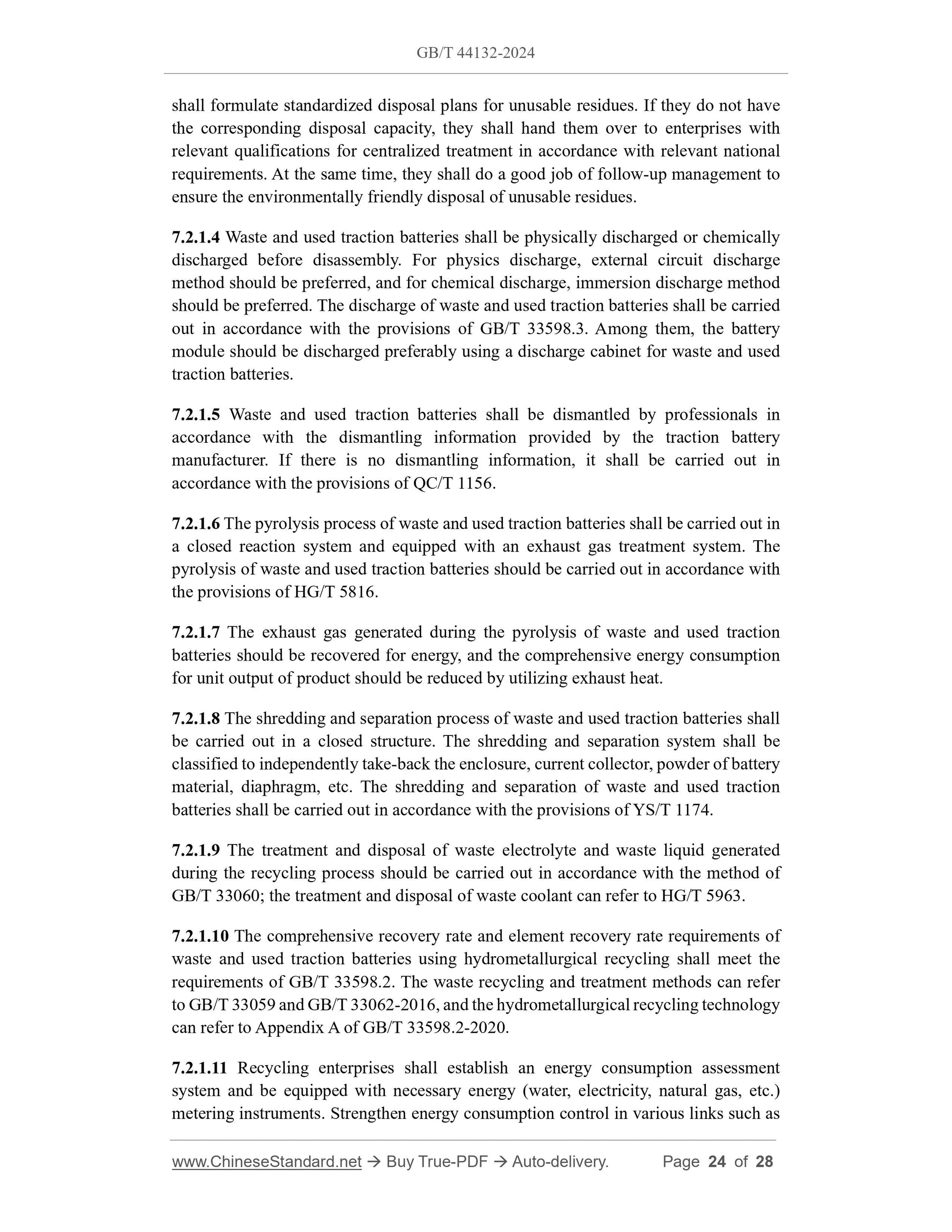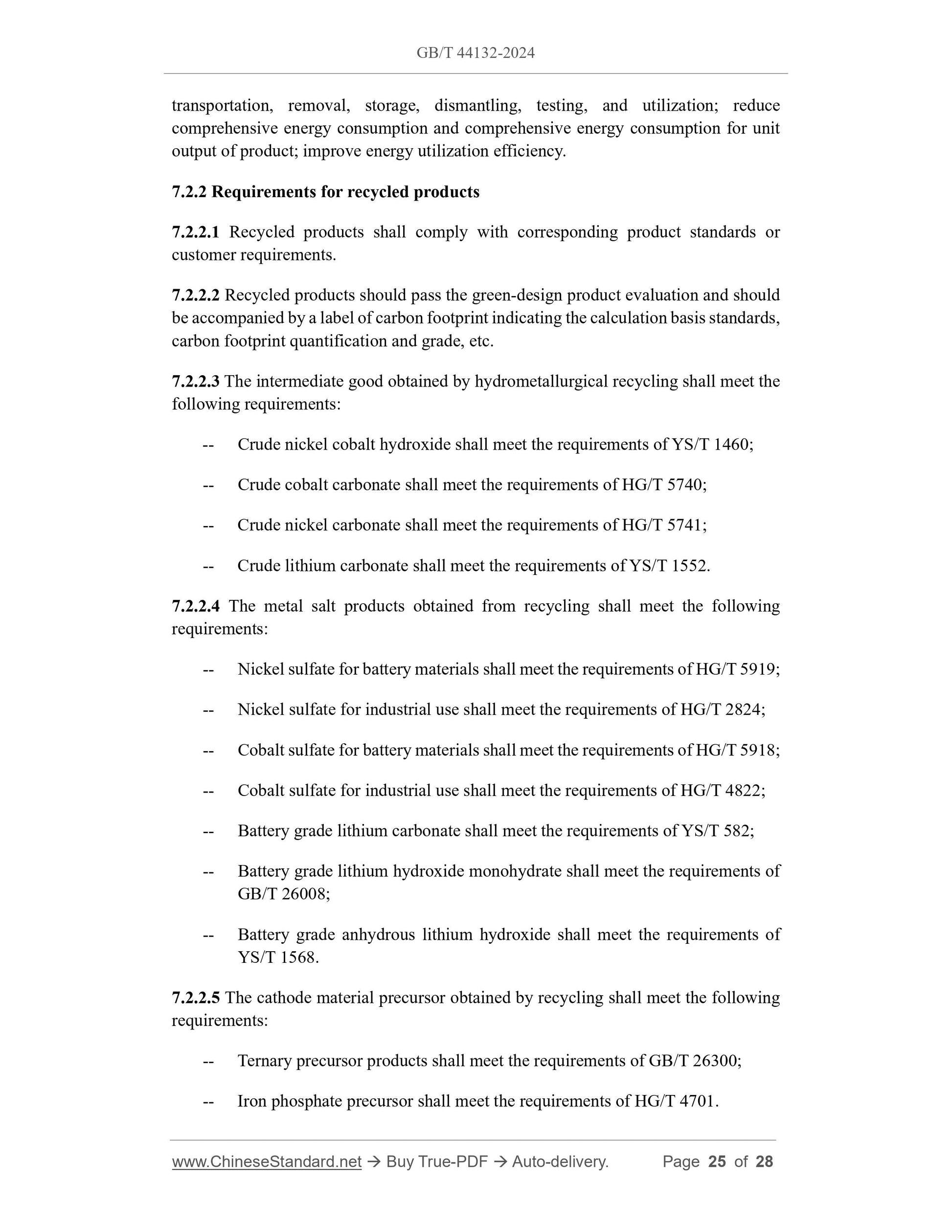1
/
of
10
PayPal, credit cards. Download editable-PDF and invoice in 1 second!
GB/T 44132-2024 English PDF (GBT44132-2024)
GB/T 44132-2024 English PDF (GBT44132-2024)
Regular price
$380.00 USD
Regular price
Sale price
$380.00 USD
Unit price
/
per
Shipping calculated at checkout.
Couldn't load pickup availability
Delivery: 3 seconds. Download true-PDF + Invoice.
Get QUOTATION in 1-minute: Click GB/T 44132-2024
Historical versions: GB/T 44132-2024
Preview True-PDF (Reload/Scroll if blank)
GB/T 44132-2024: Recovery of traction battery used in electric vehicle - General requirements
GB/T 44132-2024
GB
NATIONAL STANDARD OF THE
PEOPLE’S REPUBLIC OF CHINA
ICS 43.120
CCS T 40
Recovery of traction battery used in electric vehicle -
General requirements
ISSUED ON: MAY 28, 2024
IMPLEMENTED ON: MAY 28, 2024
Issued by: State Administration for Market Regulation;
Standardization Administration of the People’s Republic of China.
Table of Contents
Foreword ... 3
1 Scope ... 4
2 Normative references ... 4
3 Terms and definitions ... 6
3.1 Traction battery ... 7
3.2 Take-back ... 8
3.3 Recovery ... 10
3.4 Green production ... 14
4 Recovery principles ... 15
4.1 Safety principle ... 15
4.2 Green and low-carbon principle ... 15
4.3 Reuse principle ... 16
4.4 Full life cycle principle ... 16
5 Basic requirements ... 16
5.1 General requirements ... 16
5.2 Requirements for traction battery products ... 16
5.3 Traceability management requirements ... 17
5.4 Safety requirements ... 18
5.5 Environmental requirements ... 18
5.6 Recovery emergency management requirements ... 19
6 Take-back requirements ... 19
6.1 Removal requirements ... 19
6.2 Collecting requirements ... 19
6.3 Classification requirements ... 19
6.4 Packaging and transportation requirements ... 20
6.5 Loading, unloading and handling requirements ... 20
6.6 Storage requirements ... 21
7 Comprehensive use requirements ... 22
7.1 Echelon use requirements ... 22
7.2 Recycling requirements ... 23
Appendix A (Normative) Calculation method for use rate of recycled materials ... 27
Bibliography ... 28
Recovery of traction battery used in electric vehicle -
General requirements
1 Scope
This document defines the terms and definitions of the recovery process of traction
battery used in electric vehicle, and stipulates the recovery principles, basic
requirements, recovery requirements and comprehensive use requirements.
This document is applicable to the recovery of lithium-ion traction batteries and nickel-
metal traction batteries, as well as to the recovery of other types of batteries as a
reference.
2 Normative references
The following documents are referred to in the text in such a way that some or all of
their content constitutes requirements of this document. For dated references, only the
version corresponding to that date is applicable to this document; for undated references,
the latest version (including all amendments) is applicable to this document.
GB/T 19001, Quality management systems - Requirements
GB/T 19596-2017, Terminology of electric vehicles
GB/T 23331, Energy management systems - Requirements with guidance for use
GB/T 24001, Environmental management systems - Requirements with guidance
for use
GB/T 26008, Battery grade lithium hydroxide monohydrate
GB/T 26300 Nickel cobalt manganese composite hydroxide
GB/T 26493 Store and transport regulation of battery scraps
GB/T 26989-2011 Automobile recovery - Terminology
GB/T 33062-2016 Methods for disposal and recycling of nickel-metal hydride
battery material wastes
GB/T 33598 Recovery of traction battery used in electric vehicle - Recycling - Part
3: Specification for discharging
4.3 Reuse principle
Priority should be given to reusing materials generated during the recovery process, and
materials that cannot be reused should be disposed of harmlessly.
4.4 Full life cycle principle
Consideration should be given to the echelon use and recovery of future scrapped
products based on the full life cycle, starting from the new product design stage.
5 Basic requirements
5.1 General requirements
5.1.1 Enterprises that comprehensively use waste and used traction batteries should
establish and implement quality management systems, occupational health and safety
management systems, environmental management systems, and energy management
systems, and meet the requirements of GB/T 19001 or international advanced quality
management systems, as well as GB/T 45001, GB/T 24001, and GB/T 23331. Each
management system should be certified by a third-party organization.
5.1.2 Enterprises that comprehensively use waste and used traction batteries should
select production facilities and equipment with high production efficiency and
advanced energy consumption indicators, and should give priority to the use of
intelligent disassembly equipment that is compatible with a variety of battery packs and
can achieve flexible disassembly.
5.1.3 Enterprises that comprehensively use waste and used traction batteries should
build green factories. Green factories shall comply with the requirements of GB/T
36132-2018.
5.1.4 Enterprises that comprehensively use waste and used traction batteries shall
establish a carbon emission management system, including carbon emission monitoring
mechanism and data record management, etc., and should have the ability to
independently conduct organizational-level carbon emission accounting and product
carbon footprint accounting and reporting in accordance with GB/T 32150 or relevant
industry standards.
5.1.5 Traction battery product manufacturers should conduct greenhouse gas emissions
accounting and reporting in accordance with GB/T 32150.
5.2 Requirements for traction battery products
5.2.1 Traction batteries shall be coded in accordance with GB/T 34014. The coding
information shall be accurate, and the coding shall be clear, visible, durable and not
easy to replace.
5.2.2 The specifications and dimensions of traction batteries should comply with the
relevant provisions of GB/T 34013, and a standardized, easy-to-disassemble, easy-for-
echelon-use and recyclable product structure should be adopted to improve the
recyclability rate and recoverability rate of battery products.
5.2.3 Traction batteries should be accompanied by a technical information sheet on
disassembly and disassembly, indicating precautions related to recovery.
5.2.4 Traction batteries should give priority to using recycled materials as production
raw materials to reduce the carbon footprint of battery products.
5.2.5 The utilization rate of recycled materials in traction batteries shall be calculated
in accordance with Appendix A.
5.2.6 The basic information of the battery (such as manufacturer information, battery
code, battery type, recovery information, etc.) shall be reflected on the traction battery
label or instruction manual, and the following information should also be reflected:
a) The proportion of recycled materials in battery materials (including but not
limited to four elements such as cobalt, lead, lithium and nickel);
b) Label of carbon footprint of the product;
c) Electronic product identification.
5.2.7 The green-design product evaluation of traction battery products should be carried
out in accordance with the requirements of GB/T 33761-2017.
5.3 Traceability management requirements
5.3.1 Automobile manufacturers, battery manufacturers, battery leasing agencies, scrap
vehicle recycling and dismantling companies, take-back management agencies and
comprehensive use companies and other units that generate waste and used traction
batteries shall carry out traceability management.
5.3.2 Automobile manufacturers, battery manufacturers, battery leasing agencies, scrap
vehicle recycling and dismantling companies, take-back management agencies and
comprehensive use companies and other units that generate waste and used traction
batteries shall establish an information traceability management system, ...
Get QUOTATION in 1-minute: Click GB/T 44132-2024
Historical versions: GB/T 44132-2024
Preview True-PDF (Reload/Scroll if blank)
GB/T 44132-2024: Recovery of traction battery used in electric vehicle - General requirements
GB/T 44132-2024
GB
NATIONAL STANDARD OF THE
PEOPLE’S REPUBLIC OF CHINA
ICS 43.120
CCS T 40
Recovery of traction battery used in electric vehicle -
General requirements
ISSUED ON: MAY 28, 2024
IMPLEMENTED ON: MAY 28, 2024
Issued by: State Administration for Market Regulation;
Standardization Administration of the People’s Republic of China.
Table of Contents
Foreword ... 3
1 Scope ... 4
2 Normative references ... 4
3 Terms and definitions ... 6
3.1 Traction battery ... 7
3.2 Take-back ... 8
3.3 Recovery ... 10
3.4 Green production ... 14
4 Recovery principles ... 15
4.1 Safety principle ... 15
4.2 Green and low-carbon principle ... 15
4.3 Reuse principle ... 16
4.4 Full life cycle principle ... 16
5 Basic requirements ... 16
5.1 General requirements ... 16
5.2 Requirements for traction battery products ... 16
5.3 Traceability management requirements ... 17
5.4 Safety requirements ... 18
5.5 Environmental requirements ... 18
5.6 Recovery emergency management requirements ... 19
6 Take-back requirements ... 19
6.1 Removal requirements ... 19
6.2 Collecting requirements ... 19
6.3 Classification requirements ... 19
6.4 Packaging and transportation requirements ... 20
6.5 Loading, unloading and handling requirements ... 20
6.6 Storage requirements ... 21
7 Comprehensive use requirements ... 22
7.1 Echelon use requirements ... 22
7.2 Recycling requirements ... 23
Appendix A (Normative) Calculation method for use rate of recycled materials ... 27
Bibliography ... 28
Recovery of traction battery used in electric vehicle -
General requirements
1 Scope
This document defines the terms and definitions of the recovery process of traction
battery used in electric vehicle, and stipulates the recovery principles, basic
requirements, recovery requirements and comprehensive use requirements.
This document is applicable to the recovery of lithium-ion traction batteries and nickel-
metal traction batteries, as well as to the recovery of other types of batteries as a
reference.
2 Normative references
The following documents are referred to in the text in such a way that some or all of
their content constitutes requirements of this document. For dated references, only the
version corresponding to that date is applicable to this document; for undated references,
the latest version (including all amendments) is applicable to this document.
GB/T 19001, Quality management systems - Requirements
GB/T 19596-2017, Terminology of electric vehicles
GB/T 23331, Energy management systems - Requirements with guidance for use
GB/T 24001, Environmental management systems - Requirements with guidance
for use
GB/T 26008, Battery grade lithium hydroxide monohydrate
GB/T 26300 Nickel cobalt manganese composite hydroxide
GB/T 26493 Store and transport regulation of battery scraps
GB/T 26989-2011 Automobile recovery - Terminology
GB/T 33062-2016 Methods for disposal and recycling of nickel-metal hydride
battery material wastes
GB/T 33598 Recovery of traction battery used in electric vehicle - Recycling - Part
3: Specification for discharging
4.3 Reuse principle
Priority should be given to reusing materials generated during the recovery process, and
materials that cannot be reused should be disposed of harmlessly.
4.4 Full life cycle principle
Consideration should be given to the echelon use and recovery of future scrapped
products based on the full life cycle, starting from the new product design stage.
5 Basic requirements
5.1 General requirements
5.1.1 Enterprises that comprehensively use waste and used traction batteries should
establish and implement quality management systems, occupational health and safety
management systems, environmental management systems, and energy management
systems, and meet the requirements of GB/T 19001 or international advanced quality
management systems, as well as GB/T 45001, GB/T 24001, and GB/T 23331. Each
management system should be certified by a third-party organization.
5.1.2 Enterprises that comprehensively use waste and used traction batteries should
select production facilities and equipment with high production efficiency and
advanced energy consumption indicators, and should give priority to the use of
intelligent disassembly equipment that is compatible with a variety of battery packs and
can achieve flexible disassembly.
5.1.3 Enterprises that comprehensively use waste and used traction batteries should
build green factories. Green factories shall comply with the requirements of GB/T
36132-2018.
5.1.4 Enterprises that comprehensively use waste and used traction batteries shall
establish a carbon emission management system, including carbon emission monitoring
mechanism and data record management, etc., and should have the ability to
independently conduct organizational-level carbon emission accounting and product
carbon footprint accounting and reporting in accordance with GB/T 32150 or relevant
industry standards.
5.1.5 Traction battery product manufacturers should conduct greenhouse gas emissions
accounting and reporting in accordance with GB/T 32150.
5.2 Requirements for traction battery products
5.2.1 Traction batteries shall be coded in accordance with GB/T 34014. The coding
information shall be accurate, and the coding shall be clear, visible, durable and not
easy to replace.
5.2.2 The specifications and dimensions of traction batteries should comply with the
relevant provisions of GB/T 34013, and a standardized, easy-to-disassemble, easy-for-
echelon-use and recyclable product structure should be adopted to improve the
recyclability rate and recoverability rate of battery products.
5.2.3 Traction batteries should be accompanied by a technical information sheet on
disassembly and disassembly, indicating precautions related to recovery.
5.2.4 Traction batteries should give priority to using recycled materials as production
raw materials to reduce the carbon footprint of battery products.
5.2.5 The utilization rate of recycled materials in traction batteries shall be calculated
in accordance with Appendix A.
5.2.6 The basic information of the battery (such as manufacturer information, battery
code, battery type, recovery information, etc.) shall be reflected on the traction battery
label or instruction manual, and the following information should also be reflected:
a) The proportion of recycled materials in battery materials (including but not
limited to four elements such as cobalt, lead, lithium and nickel);
b) Label of carbon footprint of the product;
c) Electronic product identification.
5.2.7 The green-design product evaluation of traction battery products should be carried
out in accordance with the requirements of GB/T 33761-2017.
5.3 Traceability management requirements
5.3.1 Automobile manufacturers, battery manufacturers, battery leasing agencies, scrap
vehicle recycling and dismantling companies, take-back management agencies and
comprehensive use companies and other units that generate waste and used traction
batteries shall carry out traceability management.
5.3.2 Automobile manufacturers, battery manufacturers, battery leasing agencies, scrap
vehicle recycling and dismantling companies, take-back management agencies and
comprehensive use companies and other units that generate waste and used traction
batteries shall establish an information traceability management system, ...
Share
